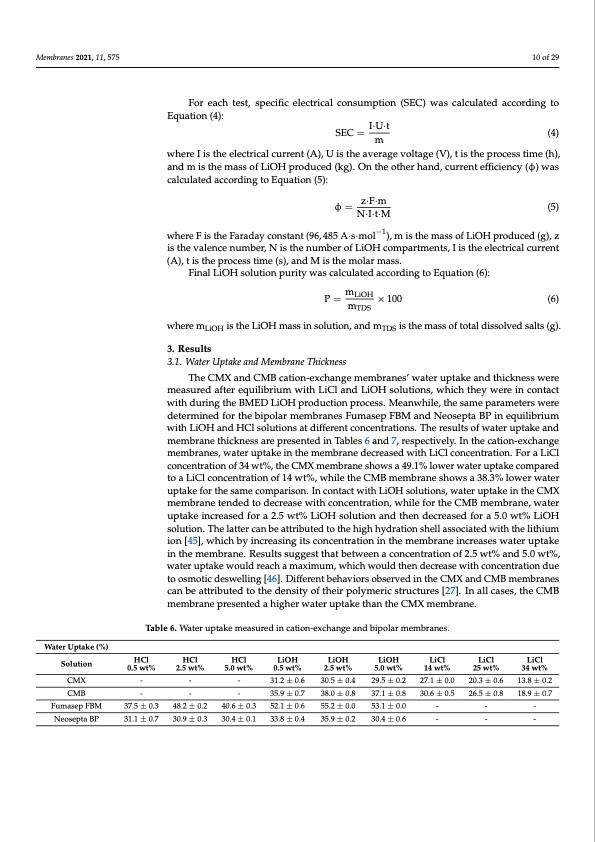
PDF Publication Title:
Text from PDF Page: 010
Membranes 2021, 11, 575 10 of 29 Water Uptake (%) Solution HCl HCl HCl LiOH LiOH 0.5 wt% 2.5 wt% 5.0 wt% 0.5 wt% 2.5 wt% LiOH 5.0 wt% 29.5 ± 0.2 37.1 ± 0.8 53.1 ± 0.0 30.4 ± 0.6 LiCl 14 wt% For each test, specific electrical consumption (SEC) was calculated according to Equation (4): SEC = I·U·t (4) m where I is the electrical current (A), U is the average voltage (V), t is the process time (h), and m is the mass of LiOH produced (kg). On the other hand, current efficiency (φ) was calculated according to Equation (5): φ= z·F·m (5) N·I·t·M where F is the Faraday constant (96, 485 A·s·mol−1), m is the mass of LiOH produced (g), z is the valence number, N is the number of LiOH compartments, I is the electrical current (A), t is the process time (s), and M is the molar mass. Final LiOH solution purity was calculated according to Equation (6): P = mLiOH × 100 (6) mTDS where mLiOH is the LiOH mass in solution, and mTDS is the mass of total dissolved salts (g). 3. Results 3.1. Water Uptake and Membrane Thickness The CMX and CMB cation-exchange membranes’ water uptake and thickness were measured after equilibrium with LiCl and LiOH solutions, which they were in contact with during the BMED LiOH production process. Meanwhile, the same parameters were determined for the bipolar membranes Fumasep FBM and Neosepta BP in equilibrium with LiOH and HCl solutions at different concentrations. The results of water uptake and membrane thickness are presented in Tables 6 and 7, respectively. In the cation-exchange membranes, water uptake in the membrane decreased with LiCl concentration. For a LiCl concentration of 34 wt%, the CMX membrane shows a 49.1% lower water uptake compared to a LiCl concentration of 14 wt%, while the CMB membrane shows a 38.3% lower water uptake for the same comparison. In contact with LiOH solutions, water uptake in the CMX membrane tended to decrease with concentration, while for the CMB membrane, water uptake increased for a 2.5 wt% LiOH solution and then decreased for a 5.0 wt% LiOH solution. The latter can be attributed to the high hydration shell associated with the lithium ion [45], which by increasing its concentration in the membrane increases water uptake in the membrane. Results suggest that between a concentration of 2.5 wt% and 5.0 wt%, water uptake would reach a maximum, which would then decrease with concentration due to osmotic deswelling [46]. Different behaviors observed in the CMX and CMB membranes can be attributed to the density of their polymeric structures [27]. In all cases, the CMB membrane presented a higher water uptake than the CMX membrane. Table 6. Water uptake measured in cation-exchange and bipolar membranes. CMX - - - 31.2±0.6 30.5±0.4 CMB - - - 35.9±0.7 38.0±0.8 Fumasep FBM 37.5 ± 0.3 48.2 ± 0.2 40.6 ± 0.3 52.1 ± 0.6 55.2 ± 0.0 Neosepta BP 31.1 ± 0.7 30.9 ± 0.3 30.4 ± 0.1 33.8 ± 0.4 35.9 ± 0.2 27.1 ± 0.0 30.6 ± 0.5 LiCl 34 wt% 13.8 ± 0.2 LiCl 25 wt% 20.3 ± 0.6 26.5 ± 0.8 --- --- 18.9 ± 0.7PDF Image | Bipolar Membrane Electrodialysis for LiOH Production

PDF Search Title:
Bipolar Membrane Electrodialysis for LiOH ProductionOriginal File Name Searched:
membranes-11-00575-v2.pdfDIY PDF Search: Google It | Yahoo | Bing
Product and Development Focus for Infinity Turbine
ORC Waste Heat Turbine and ORC System Build Plans: All turbine plans are $10,000 each. This allows you to build a system and then consider licensing for production after you have completed and tested a unit.Redox Flow Battery Technology: With the advent of the new USA tax credits for producing and selling batteries ($35/kW) we are focussing on a simple flow battery using shipping containers as the modular electrolyte storage units with tax credits up to $140,000 per system. Our main focus is on the salt battery. This battery can be used for both thermal and electrical storage applications. We call it the Cogeneration Battery or Cogen Battery. One project is converting salt (brine) based water conditioners to simultaneously produce power. In addition, there are many opportunities to extract Lithium from brine (salt lakes, groundwater, and producer water).Salt water or brine are huge sources for lithium. Most of the worlds lithium is acquired from a brine source. It's even in seawater in a low concentration. Brine is also a byproduct of huge powerplants, which can now use that as an electrolyte and a huge flow battery (which allows storage at the source).We welcome any business and equipment inquiries, as well as licensing our turbines for manufacturing.| CONTACT TEL: 608-238-6001 Email: greg@infinityturbine.com | RSS | AMP |